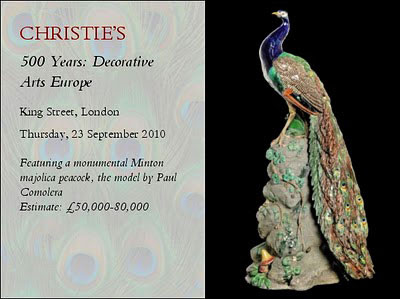Last week I wrote about the "Etruscan Devil Mug" scam that was perpetrated on majolica collectors.
Here is another one that was not quite as successful but still raises its ugly head every once in a while.
The first major reproduction I ever saw of an Etruscan piece was the phony Lily Cheese Dome that surfaced about 15 years ago. This one was a reproduction from a Michael Strawser auction photo in a hack reference book Majolica American & European Wares that was released in 1994. That photo showed a rare pink Etruscan Lily Dome from Strawser's 1993 Fall auction. Within six months a ruddy rose colored "Lily" cheese bell appeared at auctions and antique malls everywhere. The reproduction was so poorly made that they didn't even bother to glaze the inside of the dome or the underside of the base. That small detail however didn't prevent outrageous price tags from being attached to it.
Take a look at the photos below. The reproduction is one the one directly below and the genuine article is at the bottom. To my eyes they aren't even close. That rusty rose color doesn't even exist in Etruscan Majolica, not to mention the bad modeling throughout.
At the time I was working as an antiques dealer in eastern Pennsylvania. Every once in a while I'd visit one of those big reproduction wholesale markets open only to dealers to see what new reproductions had entered the market. This was the first place I ever saw these awful things, selling for $15 each. They came in a box that referenced somewhere in Asia as the point of origin. When they started showing up in malls with $1000+ price tags attached to them I was just so appalled! In several instances I tried to inform the dealers that these were reproductions from Asia. Very few listened--in fact none. Most were quite arrogant and questioned my motives. After a while I just gave up.
Here is another one that was not quite as successful but still raises its ugly head every once in a while.
Take a look at the photos below. The reproduction is one the one directly below and the genuine article is at the bottom. To my eyes they aren't even close. That rusty rose color doesn't even exist in Etruscan Majolica, not to mention the bad modeling throughout.
Reproduction cheese bell
Etruscan Majolica Lily cheese bell
At the time I was working as an antiques dealer in eastern Pennsylvania. Every once in a while I'd visit one of those big reproduction wholesale markets open only to dealers to see what new reproductions had entered the market. This was the first place I ever saw these awful things, selling for $15 each. They came in a box that referenced somewhere in Asia as the point of origin. When they started showing up in malls with $1000+ price tags attached to them I was just so appalled! In several instances I tried to inform the dealers that these were reproductions from Asia. Very few listened--in fact none. Most were quite arrogant and questioned my motives. After a while I just gave up.
For about three years these things flooded the market, then they slowly started to disappear. It gives me chills to think that they are sitting in collections all over the world with the owners being none the wiser.
If there was ever a good illustration of doing your homework before buying this is it. I can only hope no one was foolish enough to spend $1000 on it. Thank goodness they've just about disappeared off the market though they do surface every now and then. Hopefully the reference to them in my book will help prevent the ruse reproduction from being perpetuated further.



















